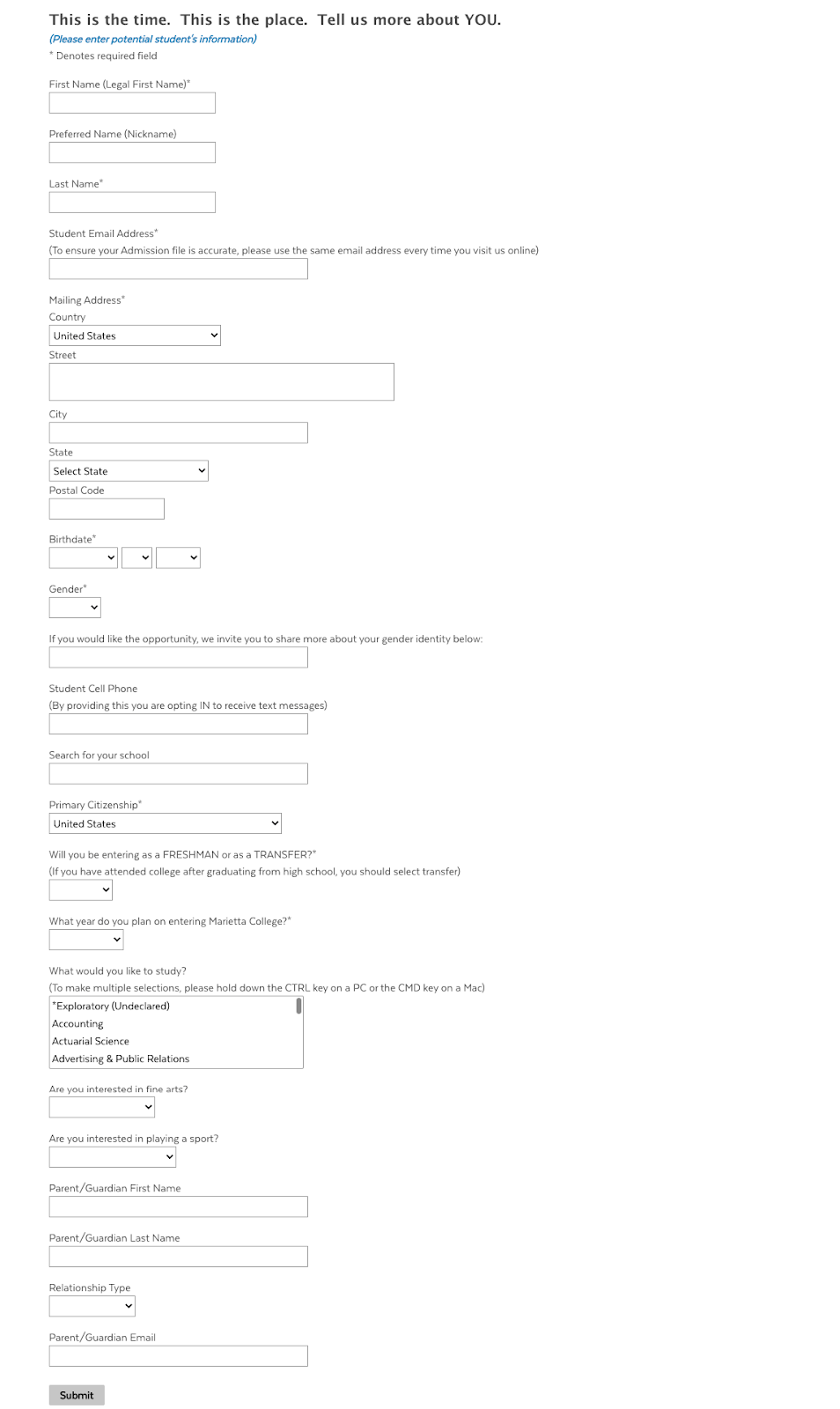How A/B testing can reverse declining university enrollment.
The Covid-19 pandemic stretched and tested all of us in almost every part of our lives, and higher ed recruitment marketing was not left on the sidelines receiving curveball after curveball after curveball. It was after swinging and missing several times that we met the team at a small private non-profit college in the northeast in January of 2021.
Covid had brought them to their knees. They had been forced to change recruitment tactics multiple times and had wasted tens of thousands of dollars on strategies that proved ineffective. The situation was so dire that the institution could no longer afford to pay our contact.
Having a true commitment to the institution, she had taken on a second job to meet the needs of her family while still trying to find some way to identify, connect with, and enroll quality students into their programs. She was down to her last attempt when we got connected with her. She was getting nowhere, despite lofty promises, with her paid media spend, and we offered to do some A/B testing and conversion rate optimization for free.
Grow enrollment.
The COVID-19 pandemic forced all colleges and universities to rethink things—online classes, graduation ceremonies, enrollment. More than a year later undergraduate enrollment is still declining, as much as 3.1 percent according to the National Student Clearinghouse Research Center.
These statistics leave institutions grappling with an age-old marketing dilemma—how do you attract and convert more website visitors with decreased budgets. The good news is that advances in split (or a/b) testing software in recent years make this problem an opportunity for university enrollment managers. A/B testing is a data-driven approach to website optimization that can achieve dramatic results in just two weeks in some cases and costs nothing to set up.
What is A/B Testing?
A/B testing creates two versions of a digital asset (webpage, form, pop-up, etc)—A and B—and shows how a sample audience responds to them in real-time. Simply put: it takes the guesswork out of website optimization.
Change the trajectory of recruitment.
A/B testing reveals what an audience responds to best through a statistical approach. Can your institution benefit from A/B testing? The short answer is yes: in fact, we would go so far as to say that colleges cannot consistently create well-optimized, high converting landing pages today without it.
There are so many opinions amongst the many team members in marketing, enrollment management, and IT. Some people will advocate for this color, others will promote new images that were just taken, while IT doesn’t understand why we need anything but paragraph text. No matter what your teams are arguing in circles about, a straightforward a/b test is your answer.
The great thing about a/b testing is that it removes ego and feelings from the equation and focuses your attention on the data. If you do the right things by students you will win, and you can tell what the right things for students are by testing.

With a/b testing opinions come second and results come first. It allows real data from real interactions to enlighten decision making and debate goes out the window. The only thing that needs to be said about any reasonable proposal is: “Let’s test it and find out!”.
A/B testing is a good fit for optimizing your most important bottom-of-funnel pages as well as the seemingly minor details of each page. You can test variables as significant as the order of information on a page or something as minor as a call-to-action.
The key is that you isolate a single variable and thoroughly test your changes against the original webpage, or control variable. Because the results of a well-organized a/b test compound every day, even a minor improvement in conversion rate can lead to seismic results. An example may help illustrate just how impactful one success a/b test can be for your business.
The Khan Academy Teaser Test
Khan Academy used A/B testing to determine whether students were more likely to enroll in a course after seeing a preview on the landing page. They knew that some students wanted more information before signing up for a new course, but they also knew that giving away more information might deter other students from going deeper. The team decided to set up an a/b test to determine which version of the landing page would yield more overall signups.
In a week they were able to run an a/b test with more than 24,000 students. The results, according to Khan Academy were definitive:
“In every measure, hiding the sneak peek resulted in greater learning outcomes. And now, we can remove the "Sneak Peek" talk-through with a degree of confidence, because we've seen that students are more likely to keep going if they don't see it.”
Of course, a/b testing can do amazing things for your enrollment numbers, but one of the biggest advantages of this approach is exactly what Khan Academy mentions—confidence. Instead of everyone sharing opinions, senior team members pulling rank, or leadership taking over, a/b testing gives your team the confidence to move forward in one direction with a decidedly better outcome. This helps your team and university constantly improve enrollment efforts without looking back. And it’s not just better for you, a/b testing also reveals what’s better for your students.
Student-first decisions
Universities’ websites are unique in that their typical website visitor is much younger than average. A recent survey of high school students found that 62% of students indicated that they would abandon a college website that is not user-friendly. In comparison, 87% of students said a well-designed website improves their opinion of a college. A new generation’s solid digital presence leaves both an opportunity, and a challenge, for colleges to meet prospective students where they are.
Today’s university students are mobile-first, digital natives and want experiences that cater to the way they browse online. They won’t wait for slow pages to load or sit around filling out lengthy forms. As you strive to build an enrollment process specifically for the next generation, consider asking for feedback on your web pages.
There are a ton of lightweight applications, like Hotjar, you can add to your website to better understand the student journey and ask for specific feedback on what brought them to the site or what they hope to accomplish. There’s no shortcut to understanding your website visitors. The more information you can get the more likely you are to build an optimal experience.
Data-driven Outcomes
A/B testing works best when done holistically–that is to say, implement this method throughout the institution’s enrollment efforts for the best results. More information is always better, but there are a few best practices you can’t ignore whether it’s your first a/b test or your thirty-first.
Identify the control
As previously mentioned, it’s crucial that you don’t completely redesign a page and start testing. Unless your goal is to just see if one webpage is superior to another. By identifying a single element to change you’ll learn over time what works best to drive students to enroll.
Choose the right tools
From Google Analytics to Optimizely, there are a lot of tools out there that describe themselves as software for conversion rate optimization. While these options vary greatly in complexity the best free tool is Google Analytics. If you’re not sure where to start, talk to a CRO expert at HALDA.
Outline meaningful goals
Not every a/b test needs to be a home run. Depending on website traffic, you may be able to run multiple tests per month and still reach statistical significance. It’s more important that your testing is set up properly and that analytics events have been identified to correctly correlate with new applications.
Ensure statistical significance
Statistical significance means that the sample size is large enough to be reflective of an entire population. Before you begin your first a/b test, you’ll need to determine how significant you want your results to be. The standard is 95% significant, sometimes referred to as confidence level. All this means is that there’s a 95% chance that the entire population of your website visitors will have the same outcome as the results of your a/b test.
There are plenty of a/b test calculators out there, but we like this one from Omni. Not only will it let you play around with different levels of significance for your results, but it will also help you gauge how many website visitors need to view your test before it’s deemed significant. The more traffic you send to the test, the faster you’ll get the results. One of the biggest mistakes in a/b testing is not waiting long enough for the results to be considered “significant.”
A practical approach to A/B tests changes the trajectory of enrollment efforts, but higher education professionals shouldn’t bite off more than they can chew. If you have the time and resources to add software scripts to your website and make changes to landing pages without oversight, then you can probably get started today. If you’re feeling a little overwhelmed by any of this then you can always reach out to a HALDA CRO expert and get a free trial started without an internal strain on your resources.
To close the loop on the story I started with: Thanks to our joint efforts and consistent a/b testing, she was able to bring in a class, build a healthy pipeline for the next one, and is back to working the ONE job that she loves: being a director of enrollment management.
Transforming your university website into an optimization machine is doable with the right tools, insights, and understanding of CRO best practices. In this case, the reward far outweighs the risk when it comes to making even the slightest improvement in conversion rates. For larger organizations starting small and getting a few wins early on will improve your chances of getting a dedicated budget and headcount for future testing. If you’re ready to get started, book a free demo with a HALDA optimization expert today.

